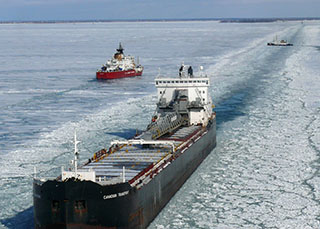With momentum building for new Arctic icebreakers, Great Lakes lawmakers are making their bid for a new vessel to supplement the Coast Guard’s only heavy icebreaker on the lakes.
“The USCG currently operates an aging fleet on the Great Lakes that includes only nine icebreaking-capable cutters, some of which date back to the 1970s,” Sens. Gary Peters and Debbie Stabenow, both D-Mich., wrote in a letter to leaders of the Senate Appropriations Committee.
The committee will be putting together Coast Guard funding for fiscal year 2016, and the Obama administration and members of Congress are pushing to start a design and build program for new icebreakers. The opening of seaways in the warming Arctic has focused attention there, and lawmakers from the Great Lakes region have been pressing to have their needs included.
“In 2006 the USCG added a heavy icebreaker called the USCG Mackinaw, but despite its addition, the USCG continues to struggle to combat the near record-breaking levels of ice coverage that have plagued the region in recent winters,” Peters and Stabenow wrote. “Heavy ice cover disrupts shipping and commerce on the Great Lakes, resulting in a severe loss of economic activity, revenue and jobs that depresses both the regional and national economy.
“During the 2013/2014 winter, U.S.-flag cargo movements on the Great Lakes dropped by nearly 7 million tons, causing at least two steelmakers to reduce production, several power plants to nearly exhaust their supply of coal, and a total estimated cost of nearly 4,000 jobs and $700 million in lost business revenue. This past winter resulted in an estimated decrease in cargo of 3.2 million tons, costing the economy $355 million in lost revenue and nearly 2,000 jobs.”
Commissioned in 2006, the 240’x58’6”x16’ 9,000-hp Mackinaw got a workout over the last couple of winters, as U.S. and Canadian icebreakers teamed up to keep traffic lanes open and assist vessels beset in ice. The same warming Arctic that has focused attention on building ships for the far north could be a cause of those recent bitter winters farther south, some climate scientists say.
Southward outbreaks of cold Arctic air – popularized as the “polar vortex” by TV weather reporters – happened when the upper atmosphere’s jet stream made deep dips north and south, bringing warmer and drier air to aggravate California’s drought, and freezing weather south to Louisiana. Heavy ice clogged East Coast waterways, and Coast Guard icebreakers have kept busy in New England and New York, too.





